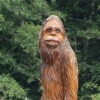The Patterson/Gimlin event is so strong for many reasons. First, there were two eyewitnesses. Secondly, there was a very good movie film footage shot. Thirdly, there were numerous castable prints left in soft soil, which had the added benefit of having the bottom of the creatures foot shown clearly in the film footage. Finally, numerous people visited the site as soon as three days later and recorded evidence themselves of the footprints and site.
One of those witnesses was an employee of the United States Forest Service, Lyle Laverty. His job as a timber cruiser put him in a position to be a point man in seeing sasquatch evidence. Sure enough, I have found reference to him finding other evidence independent to the PG event:
http://www.bigfootencounters.com/articles/laverty.htm
I have found reference to Laverty being interviewed by at least four other bigfoot researchers, but I cannot find the texts of those interviews.
Mr. Laverty's involvement appears to be quite private despite his interesting position at the time of the PG event and era in northwest California from 1955-1972. Did he approach his superiors about his experiences? Was he told to keep his mouth shut? Did he pursue evidence on his own, anyway? There is evidence that he collaborated with Dahinden, at least with regard to the PG filming event. Was he quiet about it all for fear of his job security and supervisor's orders?
If anyone has access to interviews of Laverty, I would love a PM. I would love to read them. I find him to be the most interesting character in the entire saga.


